John C. Meyer's "Petie 3rd" – Eduard 1/48
“The Legend of Y-29”:
Unternehmen Bodenplatte ("Operation Baseplate") was originally planned to commence with the Wehrmacht offensive in the Ardennes. That required bad weather to prevent Allied fighter bombers from operating; the Luftwaffe managed to put launch 500 aircraft on December 16, but operating in such bad weather proved to be beyond the capability of most units and operations were canceled. Still, over the eight days when weather conditions allowed operations between December 17-27, the Jagdwaffe lost 644 fighters with 227 damaged. This included 322 pilots killed, 23 captured and 133 wounded. On the three clear days between December 23-25, 363 fighters were lost. As a result, none of the fighter leaders expected a large-scale air operation. As it turned out, they were mistaken.
The 352nd Fighter Group had been sent over to Belgium from England on Christmas Eve, to provide additional air support for what was turning into The Battle of the Bulge. The group had flown early morning patrols over the front lines since their arrival from England, which had proven fruitful in combating Luftwaffe activities over the lines. Pilots were eager to be assigned due to the increased chance of finding the enemy. The group had kept at least one squadron available throughout the day for frontline operations.
At midnight January 31, Lt. Colonel John C. Meyer, recently promoted from command of the 487th squadron to Deputy Group Commander when Colonel Jim Mayden took command of the Blue Nosers, was interrupted while planning the first dawn patrol of 1945 by orders from “Football” - IX Air Force headquarters - directing the 352nd to prepare a “maximum effort” escort mission the next day. This meant there would be no early morning patrol. Meyer immediately informed Colonel Mayden and the three squadron commanders. All were dismayed, since there had been so much Luftwaffe fighter activity over the front lines and the patrols had been so effective. They examined the order, looking for a way to comply and also provide the patrol. Calls to headquarters to modify the order were unsuccessful. Frustrated, Meyer turned in with orders to wake him at dawn, in case things changed.
Dawn found Y-29 covered in thick fog, which would delay operations. At 0800 hours, Meyer called again, asking for a change in orders - could they put up three 12-plane squadrons, leaving 12 for patrol? He was told to wait 20 minutes; the response was negative. Not one to give up when he believed he was right, Meyer placed a direct call to General Pete Quesada. This time, Meyer mentioned the possible threat of enemy attack while taking off for the escort as reason to have a patrol. Quesada put Meyer on the spot: would he personally state the fighters were needed for patrol because of a threat, and take responsibility for anything that happened if the order was changed? With Meyer's yes, Quesada approved the patrol at 0845 hours.
By 0900 hours, the weather began clearing. The patrol would fly to St. Vith, the logistical bottleneck for Wehrmacht activity on the front after their failure to take Malmedy and Bastogne; then return in time to provide cover for the escort take-off. “Transport” (radio callsign for the 487th) White, Red, and Blue flights would make up the patrol. Meyer would lead as Transport White One. The pilots readied for start-up when the fog lifted sufficiently to allow take-off.
Finally, at 0915 hours, the fog lifted; eight Ninth Air Force P-47s from the 390th squadron of the 366th Fighter Group took off, disappearing in the ground haze. The 12 blue-nosed P-51s taxied to the runway. As Meyer accelerated for take-off, he saw black puffs from anti-aircraft gun explosions and tracers from machine guns whip the sky ahead. When he asked the control tower what was happening, they replied there was nothing. But the flak bursts got thicker as he passed the halfway point and spotted black specks low on the horizon.
A moment later, one speck turned into a Fw-190 that seemed to fly directly at Meyer, who could only continue accelerating to flying speed. The enemy fighter opened fire and Meyer momentarily ducked. Then he realized he wasn't the target when he saw the C-47 parked next to the runway take hits. When his airspeed indicator hit 100 mph, Meyer hauled the Mustang off the runway and immediately retracted his landing gear. He pulled the trigger and saw tracers hit the Fw-190's engine. It swerved toward him, then nosed down. Meyer flew over the stricken fighter so close that a collision was missed by inches.
Observers saw the Fw-190 explode when it hit the ground; momentarily, it was unclear if the two had collided. Then Meyer banked away beyond the rising cloud of black smoke.
The fog was now a strong haze, making it difficult to identify shapes in the sky. Below, other Mustangs lifted off and tucked their gear. Reaching 2,000 feet, Meyer saw two indistinct shapes ahead. Closing, he momentarily took them for P-47s, then recognized them as another pair of Fw-190s. He closed on the wingman. When its wingspan filled the sight reticle, he opened fire. He spotted a Bf-109 curve in on his left rear, still out of range. The Fw-190 ahead took hits but he couldn't hold fire on it as he bounced in the propwash.
Suddenly the Fw-190 ahead split-Sed from 3,000 feet. Meyer turned hard left as the 109 fired and missed him. An instant later, a blue-nosed P-51 turned onto the 109s tail and opened fire; the enemy pilot turned away. Meyer saw the Fw-190 with streamers from the wingtips as it pulled out so low it seemed to hit the trees. He dived to finish the fight but was suddenly hit by anti-aircraft fire! A hole opened in the Mustang's wing. Meyer took another hit; he banked away from the “friendly” fire. The 190 started climbing and Meyer opened fire. The enemy pilot banked, looking to crash land. As he touched down, he caught a wingtip and the fighter somersaulted, broke up and exploded. Meyer departed the battle area, knowing he was too low on ammo to get in a third fight.
Meyer's wingman, 1st Lieutenant Alex Sears, remembered, “We had just taken off when
we were bounced by forty or fifty Me-109s and FW-190s. One Me-109 came at me head-on and we made several passes at each other, both of us firing. On the third pass I got some strikes on his engine and shot part of the tail section away. He started burning and went down in a lazy spiral and crashed.”
Meyer's element leader, White Three 1st Lieutenant Ray Littge, shot down a Fw-190 as he lifted off. He chased another that took hits but kept on going, emitting huge clouds of black smoke. Littge kept shooting until he was out of ammunition, following it until the pilot bailed out in the vicinity of Paris.
Littge's wingman, 2nd Lieutenant Alden Rigby shot an Fw-190 off Littge's tail, then turned onto another 190. “I dropped down on his tail and my gunsight went out, so I fired a long burst until I noticed hits on his wing roots. He started pouring black smoke and lost altitude until he crashed into the trees. I immediately returned to the field and noticed a P-47 in a Lufbery with a '109. The P-47 fired a short burst and I noticed a few strikes on the '109. He tightened his turn; as the P-47 mushed, I came in and fired a long burst.He crashed in an open field.” Nearly out of ammo, Rigby circled to land, b ut ran across another fight between two P-51s and a Bf-109.
“The '109 broke in my direction and I fired the remainder of my ammo at him, scoring at least one hit in the cockpit. The enemy aircraft dived straight into the ground.' Rigby claimed two Fw-190s and two Bf-109s, one possibly shared with an unidentified P-47 and the other possibly shared with an unidentified P-51. He would not get full credit for the two Bf-109s for 55 years.
Major Bill Halton's Yellow Flight followed White Flight into instant combat. Dodging enemy fighters on takeoff, element leader 1st Lieutenant Sanford Moats shot down four Fw-190s while his wingman 2nd Lieutenant Henry Stewart scored three Bf-109s. Flight leader Halton and his wingman 2nd Lieutenant Dean Huston got an Fw-190 each.
By the time Captain Bill Whisner's Blue Flight got airborne, the sky was filled with enemy aircraft; he scored his first while climbing from takeoff. He later reported: “I ran into about thirty Fw-190s at fifteen hundred feet. I picked one out and pressed the trigger. Nothing happened. I reached down and turned on my gun switch and gave a couple of good bursts.” As Whisner saw number one hit the ground and explode, he felt hits. “A '190 was about 50 yards behind me, firing away. As I was turning with him, another P-51 attacked him and he broke off his attack on me. I then saw that I had several 20 mm holes in each wing and another round hit my oil tank. My left aileron was also out and I was losing oil, but my temperature and pressure were steady.”
Whisner was aggressive enough that despite the damage, he turned toward a big dogfight and quickly caught another Fw-190. “After I hit him with several bursts, the pilot tried to jump. Just as his canopy came off I fired again and the '190 rolled over, crashed and exploded.” He then came across a flight of Bf-109s and engaged one. “We fought for five or ten minutes and I finally managed to get behind him. I hit him good and he went down. At this time I saw some fifteen to twenty fires on the ground from crashed airplanes.”
The field was still under attack as Whisner turned back. “I saw a '109 strafe the north-eastern portion of the strip. I started after him and he turned into me. We made two head-on passes and on the second I hit him in the nose and wings. He crashed and burned. I chased several more bandits, but they evaded me in the clouds. By now my windshield was covered with oil, so I headed back to the strip and landed.” Whisner, already an 11-victory ace, had just become “an ace in a day” fighting over his own airfield.
The attack on Asch was assigned to JG 11. I./JG 11 had only 16 Fw-190s on strength and six pilots. The lack of numbers was made up from III./JG 11, which had more pilots than aircraft. Only 41 Fw-190s - four from the Stab; six from I/JG 11 and 31 from III/JG 11; and 20 Bf-109s from II/JG 11 took part in the attack. The plan called for a strafing attack by the more heavily-armed Fw-190s, while the Bf-109s were top cover. While crossing Allied lines, four fighters were lost to anti-aircraft. Their path took them directly over the Allied airfield at Ophoven, three miles from Asch and home to the Spitfire XIV fighters of No. 125 Wing RAF; 30 Fw 190s and Bf 109s attacked the field in the mistaken belief it was Asch.
The 45-minute battle at Y-29 went into the record books as “The Legend of Y-29,” the wildest fight any Eighth Air Force fighter unit ever engaged in. The pilots of the 487th were credited with 24 destroyed. No P-51s were lost; two were damaged and one was damaged on the ground. The 366th Fighter Group lost one P-47 and was credited with eight destroyed while the airfield ground defenses claimed seven. JG 11 reported the loss of 28 Fw-190s and Bf-109s. Four pilots made it back to German territory, while four were captured and 20 killed. JG 11 Kommodore Oberstleutnant Günther Specht and III/JG 11 Gruppenkommandeur Hauptmann Horst-Günther von Fassong were among those killed.
The 487th squadron's performance was so impressive it was the only Air Force fighter squadron ever awarded the Distinguished Unit Citation. Distinguished Service Crosses were awarded to John C. Meyer (his third); Bill Whisner (his second); and Sanford Moats. Major William Y. Halton, Captain Henry M. Stewart, and Lieutenants Raymond Littge and Alden Rigby were each awarded the Silver Star. For John C. Meyer, this was his lastfight; he was injured in a jeep accident a week later and hospitalized for the rest of the war. He later wrote of New Year's Day 1945: “For the first time in my experience in the European air war, American fighters had neither the advantage of superior tactical position, numbers or equipment. For the first time there was no measurement involved in the final determination other than the relative skill and initiative of the pilots. It was no time for leadership or organization. It was man against man.”
(Adapted from: “A Clean Sweep: VIII Fighter Command vs. The Luftwaffe 1942-45", coming from Osprey in May 2023)
The Kit:
Eduard's P-451D kits have now been with us since August 2019, and are rightfully considered the definitive kits of the P-15D in 1/48. The range of “bubbletop” P-51s is covered with releases of the “finless” early P-51D-5, the “classic” P-51D in early, middle, and late production, the P-51K and the F-6D. Most modelers aren't crazy enough to get all the releases, but if there is one that meets the classification of “definitive of the definitive,” it is this one, Profipack kit 82102. The six markings options cover five of six of the best-known “ace Mustangs,” and one that's never been done before. They are: Glenn Eagleston's “Eagle;” Captain John Voll's “American Beauty;” Pierce McKennon's “Ridge Runner III;” Jim Tapp's “Margaret IV;” and John D. Landers' “Big Beautiful Doll.” The one that's never been done before is John Meyer's “Petie 3rd;” the least-known of his airplanes - there is only one photo, discovered by Robert “Punchy” Powell when he went through the personal effects of Meyer's late crew chief back in the 1990s - “Petie 3rd” is the most important of his airplanes, since he scored half of his 24 victories in her between mid-November 1944 and New Year's Day 1945. Eduard gets extra points for doing this one. (When you see a P-51 model with "Petie 2nd" markings and more than 12 swastikas on it, you will be reminded again that "research" by decal designers is "hit and miss.")
While they get extra points for doing “Petie 3rd,” Eduard also managed to mess up Pierce McKennon's “Ridge Runner III.” It's not fatal - far from it; in fact it gives you the opportunity to do “Ridge Runner II,” the airplane involved in the famous “piggyback rescue.” Eduard shouldn't be faulted here: “Ridge Runner” II, III and IV are easy to confuse, since each has exactly the same markings and differ only between being a P-51D-10 (RR II) that may have fabric elevators; a P-51D-20 (RR III) and a P-51D-25 (RR IV); the sole obvious differentiation is their serial numbers, and the minor detail that RR II only has one parachutist in the marking. McKennon went through all three between late March and late April 1945. So, if you carefully paint out one of the parachutists in the decal, and use the “curved” P-51D-10 dorsal fin, and flip a coin as to whether you use fabric or metal elevators (I would go with metal, personally), you can end up with the airplane McKennon bailed out of to be rescued by George Green, which hasn't been done before.
This particular Profipack release was - unsurprisingly, given the subject matter - Eduard's most popular release of the kit, and has just been re-released for those who missed it the first time around.
Construction:
It's an Eduard kit. Clean up all the sprue nubs, because fit is very precise. Follow the instructions and get a great model.
However, if you vary from the instructions and glue part G-34 (the “roof” of the wheel well) to the floorboard of the cockpit (part H-34) rather than to the top of the wheel well (part G-36), you will have an easier time of getting the wing and fuselage sub-assemblies to slip into place. I do this all the time now with my Eduard P-51s.
Painting and Decals:
First, I painted the nose and rudder dark blue and masked them off. The 352nd Fighter Group started painting the noses a darker blue around October 1944, since it aided identification, which was the purpose of the marking to begin with. It is unclear what this color actually was, though some have theorized it was RAF Dark Mediterranean Blue, which would have been easily available at the time. I used Tamiya X-6 “Royal Blue” for this.
I then painted the wings with Tamiya XF-1 “Flat Black” and the rest of the model with Tamiya X-18 “Semi-gloss Black,” as primer for the Vallejo metal paints. I later used decals from an Airfix P-51D sheet for the wing and stabilizer stripes, but at this point you could mask them off. I did mask off the black ID stripe markings on the lower rear fuselage; these were 15 inches wide like the wing/stabilizer ID stripes, not the 18 inches of standard “D-Day” stripes.
I painted the wings Vallejo “Dull Aluminum,” to simulate the aluminum lacquer used on the wings. When that had dried overnight, I used drafting tape, a very low-tack masking tape available at artists supply stores that won't lift a fragile paint like Vallejo, and masked off the wings. I then painted the rest of the model with Vallejo Aluminum. I finished off by painting some panels with “Semi-matte Aluminum” and “White Aluminum.” This can be applied with a brush, since Vallejo dries without brush strokes, and means you don't have to mask off these areas with the possibility of pulling up paint.
The decals went down without problem.
Final Finish and Assembly:
I assembled the main gear and attached it, making sure that it was set so that when I looked down at the wing from directly overhead, the main gear axle was visible just ahead of the wing leading edge, which assures that the gear is correct. I unmasked the canopy and attached it in the open position.
Overall:
Thank Eduard for doing the “Petie” that wasn't “done to death” with photos; interestingly, “Petie 2nd” may be the best-known of Meyer's P-51s from the number of photos, but it was his least-successful airplane, since he scored no victories in it. “Petie 3rd” is the one you want, and Eduard has given it to us. Recommended for modelers experienced in Eduard kits.
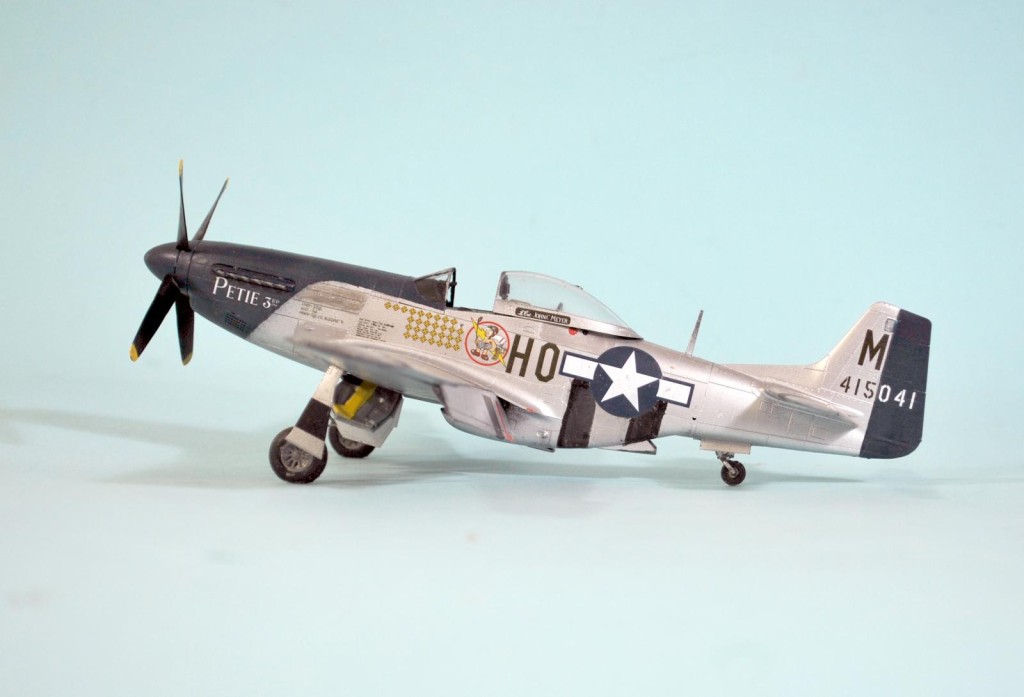
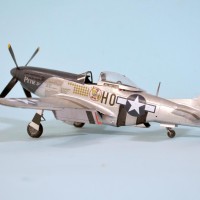
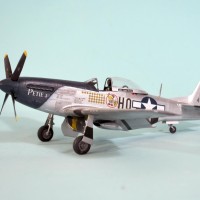
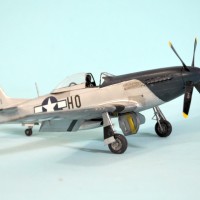
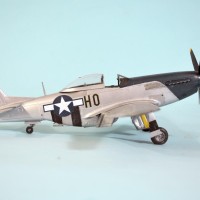
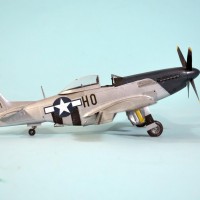
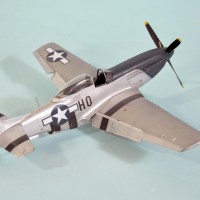
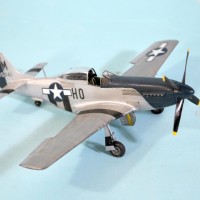
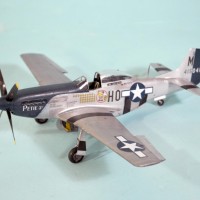
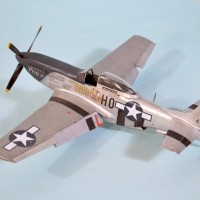
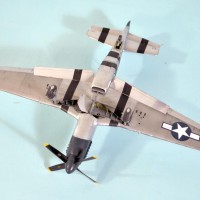
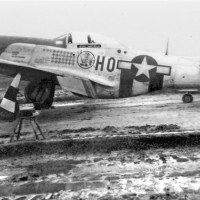
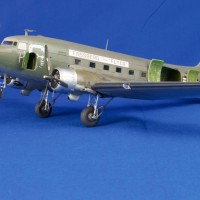
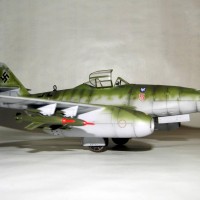
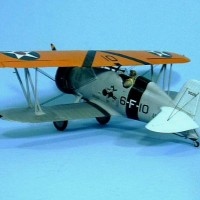
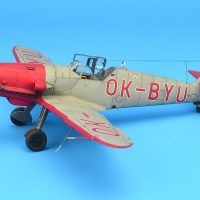
Another quality article, both the reading and the model. How many Eduard Ponies have you built so far Tom? I feel so ashamed for having three unbuilt when I see your beautiful Mustangs regularly in the headlines
Many. 🙂
There's no such thing as too many Mustangs (or Spitfires). This one came about while writing "A Clean Sweep: VIII Fighter Command vs the Luftwaffe" and discovering the facts about Petie 3rd (I had consigned Meyer's pony to "done to death" then discovered I was wrong and discovered Eduard put it on their sheet)
Another excellent Pony and an absolutely great article, Tom!
Get ready to buy the book next May, 2023. 🙂
A great looking Mustang, Tom @tcinla
The "Petie 3rd" is one that has to be in your collection as well, regardless of how many Mustangs you already have.
Thanks a lot for the great supporting article.
Reads like a movie. Sometimes reality is better than fiction. Who was that guy in GreyHound? Great outline for a movie that lasts 1hr 31mins. A movie with Petie? With cartoon characters on the side . . . with a time line with a hero that makes decisions based on his gut feelings, risking it all for his men and country. Common on, this story needs to be made on film.
I know Mustangs where made in production blocks and this build is testimony to how fast pilots either consumed their mounts or they where shot out from underneath them. " McKennon went through all three (Mustangs)between late March and late April 1945." WWII was the large scale beginnings of a throw away society based on the needs of war.
Great article and build TC. I could see the written word in my eye's mind with each paragraph.
Two thumbs up.
Yeah, go on, plug your war book.
Love your articles
Your writing is always interesting and your work impeccable once again
Flattery will get you everywhere! 🙂
Thank you.
Great article as always, and a beautiful blue-nose Pony. Well done.
Nice job, Tom.
I like read Your article! Love air war history! Great job with Mustang!
Superb details Tom Meyer's mustang looks just right and your write up brings the story to life for those that don't know